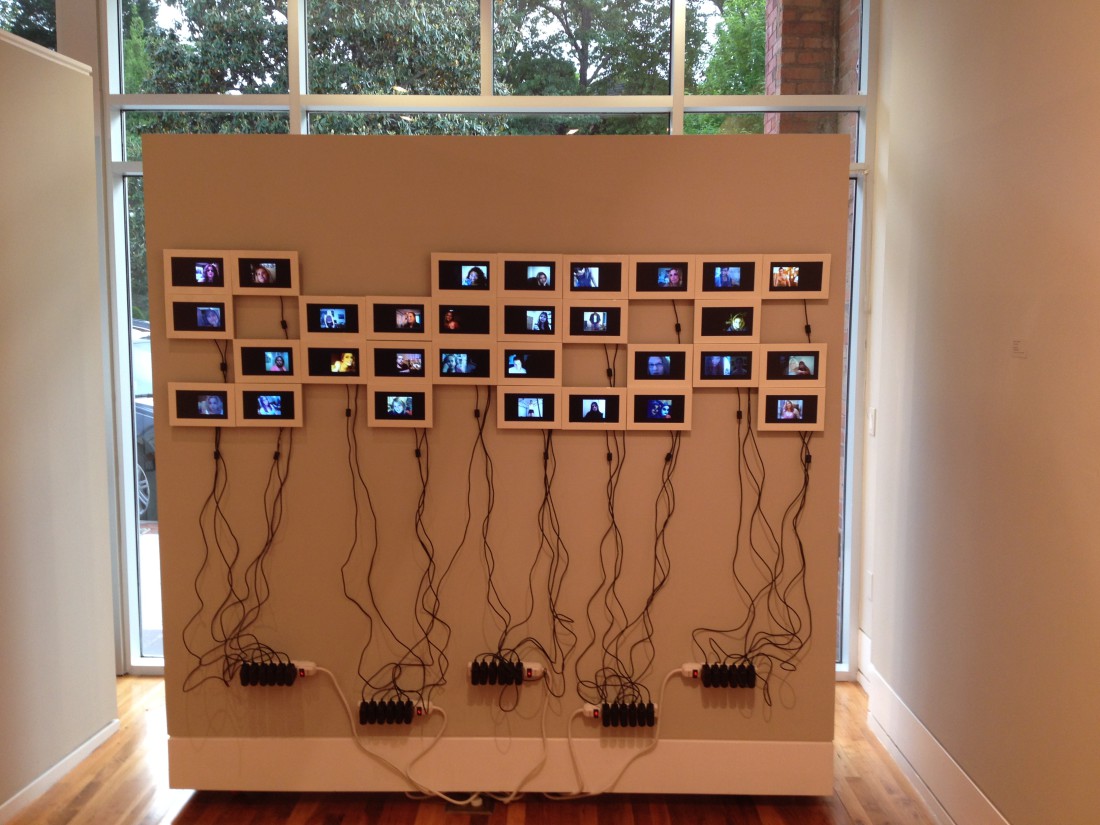Selfie-obsessed
If the advent of the camera single-handedly changed our perceptions of portraiture in the 19th century, then it could be said that the selfie is certainly our generation’s most consequential mark on the portrait. In late 2013, “selfie,” a word born out of a chatroom thread in 2002, was officially added to the Oxford English Dictionary, where it enjoyed an extra moment in the literary spotlight as the OED’s “word of the year.” As this simple act of photographing oneself at arm’s length continues to thrive in the social media stratosphere, selfies and similar digital photo-based imagery are gaining ground in the world of fine art, where they’re influencing contemporary portraiture and media installations.
In John D. Monteith: Portraits, a new exhibition on view through Friday, June 20, at Upstairs [Artspace] in Tryon, we find just that — an artist invigorated by and instilling his own digitally evolving social landscape into portraiture, selfies included. The show features a series of oil portraits and diptychs that Monteith, a Columbia, S.C.-based artist, painted using images from photo shoots. While many artists work from photographs for guidance, Monteith paints the visual degradations of the photograph itself. Each painting-to-be is printed out on his home printer, which is admittedly sub-standard. It’s also precisely what gives Monteith’s paintings their softened forms and surreal, saturated color. The portraits are cropped down, giving each work a theatrical, frozen element.
In “Untitled (w8),” a women cranes her head out of a loosely rendered bathtub. She’s fully clothed, in full makeup and with a scarf around her head. Like the other women in Monteith’s portraits, this character has pale, porcelainlike skin brought out by the smoothness of the oil paint and the Dura-Lar paneling.
The diptychs take that abstract balancing act a step further by getting even closer. Some works reveal only an eye in a mass of cloth and tattooed skin. Others present a larger view, but immediately cover it with a gloved hand or straps of cloth. To say they’re sensual is to overlook the measures Monteith’s taken to obscure and anonymize his subjects.
In between the two walls of portraits rests “The Free World,” a digital video installation composed of 30 4-by-6-inch LCD screens. The work features digital stills from Monteith’s collection of over 16,000 selfies, each one culled from online chatrooms. Most were downloaded from profile pictures that North and South Carolina residents took with webcams and clunky, early-model digital cameras. All are from the Internet’s glitchy, low-res infancy between 1999 and 2005. “Back in the day, there was no way to control privacy, so all of these were public,” Monteith says. “In a sense, they’re paleo-selfies.”
These developmental years of chatrooms and similar social media outlets had a certain luster to them. Maybe it was our short-lived ignorance in understanding just how public the Web was, or thinking that we were truly alone on the Internet. But that newness unleashed a certain bravado in those willing to explore the then-uncharted territory, Monteith says. These scouts and surveyors are his subjects; they form a collective digital coming-of-age archive.
Men and women slouch, flex and flaunt their bodies in bathrooms, bedrooms and kitchens. They pose with household objects, sprawl across couches and stare endlessly into the glow of their computer screens. Some have guns. Others are showing off Christmas presents. An overwhelming number of them are naked while others are in mid-striptease. One image even features a man in a casket with an explanatory note taped above him — a kind of postmortem selfie.
There’s an initial joyous shock at viewing the work, seeing the thousands of individuals from every walk, size and shape of life in an endless cycle, all pining for attention. It spurs an anxious and addled surge that’s not unlike looking at a debauched family album, fearing that you may be tucked in there somewhere. You could be, after all.
But as the gravity and breadth of the work sets in, so does a sense of scrutiny. The work could be construed as an ode to narcissism, though Monteith disagrees. “Taking the pictures isn’t nearly as narcissistic as posting them online,” he says. Nearly all of these images were directed to one or a few private recipients, so he sees them with a certain innocence: more like genuine exploration than the vanity associated with Facebook and Instagram.
“It’s really no different than looking at yourself in the mirror,” Monteith says. “It’s just part of being human.”
View John D. Monteith: Portraits through Friday, June 20, at Upstairs [Artspace] in Tryon. The gallery is open Tuesday through Saturday from 11 a.m. to 5 p.m. and is free to attend. upstairsartspace.org




Before you comment
The comments section is here to provide a platform for civil dialogue on the issues we face together as a local community. Xpress is committed to offering this platform for all voices, but when the tone of the discussion gets nasty or strays off topic, we believe many people choose not to participate. Xpress editors are determined to moderate comments to ensure a constructive interchange is maintained. All comments judged not to be in keeping with the spirit of civil discourse will be removed and repeat violators will be banned. See here for our terms of service. Thank you for being part of this effort to promote respectful discussion.